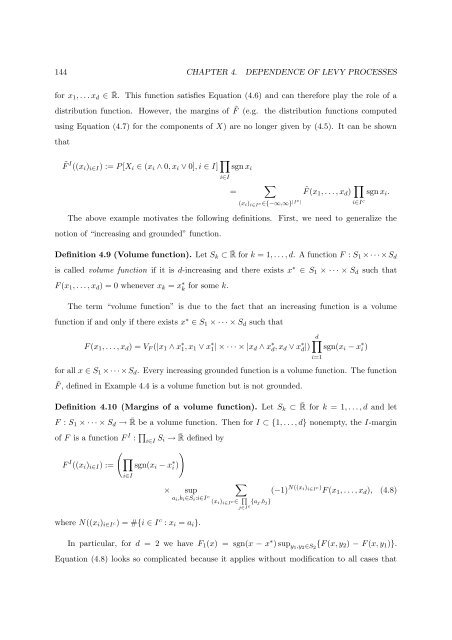Processus de Lévy en Finance - Laboratoire de Probabilités et ...
Processus de Lévy en Finance - Laboratoire de Probabilités et ...
Processus de Lévy en Finance - Laboratoire de Probabilités et ...
Create successful ePaper yourself
Turn your PDF publications into a flip-book with our unique Google optimized e-Paper software.
144 CHAPTER 4. DEPENDENCE OF LEVY PROCESSES<br />
for x 1 , . . . x d ∈ ¯R. This function satisfies Equation (4.6) and can therefore play the role of a<br />
distribution function. However, the margins of ˜F (e.g. the distribution functions computed<br />
using Equation (4.7) for the compon<strong>en</strong>ts of X) are no longer giv<strong>en</strong> by (4.5). It can be shown<br />
that<br />
˜F I ((x i ) i∈I ) := P [X i ∈ (x i ∧ 0, x i ∨ 0], i ∈ I] ∏ i∈I<br />
sgn x i<br />
=<br />
∑<br />
(x i ) i∈I c ∈{−∞,∞} |Ic |<br />
˜F (x 1 , . . . , x d ) ∏ i∈I c sgn x i .<br />
The above example motivates the following <strong>de</strong>finitions.<br />
notion of “increasing and groun<strong>de</strong>d” function.<br />
First, we need to g<strong>en</strong>eralize the<br />
Definition 4.9 (Volume function). L<strong>et</strong> S k ⊂ ¯R for k = 1, . . . , d. A function F : S 1 × · · ·×S d<br />
is called volume function if it is d-increasing and there exists x ∗ ∈ S 1 × · · · × S d such that<br />
F (x 1 , . . . , x d ) = 0 wh<strong>en</strong>ever x k = x ∗ k<br />
for some k.<br />
The term “volume function” is due to the fact that an increasing function is a volume<br />
function if and only if there exists x ∗ ∈ S 1 × · · · × S d such that<br />
d∏<br />
F (x 1 , . . . , x d ) = V F (|x 1 ∧ x ∗ 1, x 1 ∨ x ∗ 1| × · · · × |x d ∧ x ∗ d , x d ∨ x ∗ d |) sgn(x i − x ∗ i )<br />
for all x ∈ S 1 ×· · ·×S d . Every increasing groun<strong>de</strong>d function is a volume function. The function<br />
˜F , <strong>de</strong>fined in Example 4.4 is a volume function but is not groun<strong>de</strong>d.<br />
Definition 4.10 (Margins of a volume function). L<strong>et</strong> S k ⊂ ¯R for k = 1, . . . , d and l<strong>et</strong><br />
F : S 1 × · · · × S d → ¯R be a volume function. Th<strong>en</strong> for I ⊂ {1, . . . , d} nonempty, the I-margin<br />
of F is a function F I : ∏ i∈I S i → ¯R <strong>de</strong>fined by<br />
( )<br />
∏<br />
F I ((x i ) i∈I ) := sgn(x i − x ∗ i )<br />
i∈I<br />
∑<br />
× sup<br />
(−1) N((x i) i∈I c ) F (x 1 , . . . , x d ), (4.8)<br />
a i ,b i ∈S i :i∈I c<br />
(x i ) i∈I c ∈ ∏<br />
j∈I c{a j,b j }<br />
where N((x i ) i∈I c) = #{i ∈ I c : x i = a i }.<br />
In particular, for d = 2 we have F 1 (x) = sgn(x − x ∗ ) sup y1 ,y 2 ∈S 2<br />
{F (x, y 2 ) − F (x, y 1 )}.<br />
Equation (4.8) looks so complicated because it applies without modification to all cases that<br />
i=1
















